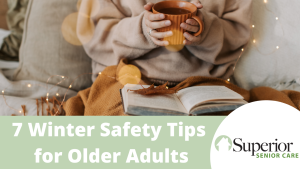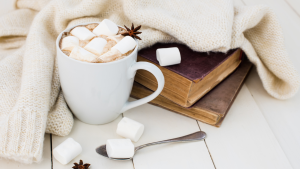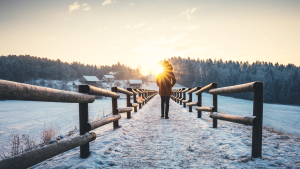
Winter is here! It is very important to keep yourself and the older adults in your life safe and warm during this time of year. Many people may not know that the older we get, the faster we lose body heat, and with that change it becomes harder to notice that you are getting cold. This can lead to dangerous problems for older adults, like hypothermia. The colder weather also brings high risks of injuries related to snow and ice. If you aren’t able to migrate south this winter season, it’s a good idea to be prepared to stay healthy, warm, and safe during these colder months. We have compiled a list of tips separated into indoor safety and outdoor safety to keep you and your loved ones safe in all environments.
Indoor Safety:
1. Keep Warm Inside. Hypothermia is a serious condition caused by cold weather that can happen both outside or inside, it can occur anytime the body temperature drops to a dangerous level for an extended period of time. As mentioned above, older adults lose body heat quicker than when they were younger and may not be aware that they are getting cold.
Some early signs of hypothermia to look out for are; cold hands and feet, puffy or swollen looking face, shivering (this is not always a symptom, some people may shiver just because they are cold and some people with hyperthermia may not shiver), slurring words or slow speech, acting sleepy, or being confused or easily angered. Some later signs of hypothermia could be; trouble with balance or walking, moving slowly, jerky or stiff movements, slow heartbeat or breathing, or losing consciousness/blacking out.
If you think someone has these warning signs of hypothermia, call 9-1-1 immediately. After you have contacted 9-1-1, try to move the person to a warmer place and wrap them in something warm like a blanket, towel, or coat. If you don’t have anything warm to wrap them in, you can also use your own body heat by gently lying close to them. You can also give them something warm to drink like a hot tea, hot water, or warm milk, however do not give them beverages with alcohol or caffeine as these beverages can contribute to the loss of body heat. Also, avoid trying to warm them in a bath or with a heating pad.
Some ways to prevent hypothermia are to stay indoors, keep the indoor temperature at least at 68–70°F, and dress warmly, even indoors. On extra cold days, it’s a good idea to keep a blanket over your legs and wear warm (non-slip) socks or slippers during the day, and to use extra blankets or covers and wear warm pajamas or long underwear to bed at night.
With the rising electric and gas prices these days, some people may find it hard to pay their heating bills. A few resources that might help:
- National Energy Assistance Referral service or give them a call at 1-866-674-6327 (TTY 1-866-367-6228)
- email the National Energy Assistance Referral (NEAR) project to get information about the Low Income Home Energy Assistance Program.
- Contact your state or local energy agency or local power or gas company, they may have special programs that help pay the heating bills for people with a limited income.
2. Winterize Your Home. Since your home is the safest place to be during the winter months, it’s important that you prepare it for winter weather. You’ll want to make sure that your house isn’t losing any heat through windows or doors, so installing weather stripping, caulking, and insulation is a great idea. Insulating exterior wall water lines can prevent unexpected bursting of pipes. It’s also a good idea to clean out gutters, repair leaks in the roof, and remove any dead trees or leaf debris that can be hazardous to not only your home but could be a slip hazard as well. Getting your home winterized can help keep heating bills down. Your local power or gas company may be able to give you more information about ways to weatherizing your home to keep bills low.
There’s a higher risk of fires or carbon monoxide poisoning during the winter months, so it’s important to know about these dangers and how to prevent them. Make sure your heating system is working properly, is clean, and is ventilating to the outside by having it professionally serviced. Indoor fireplaces, chimneys, gas and wood stoves, and gas appliances can leak dangerous amounts of carbon monoxide, so it’s a good idea to have them inspected and cleaned before their first use each winter. It’s also a good idea to have a safe alternative heat source along with sufficient backup fuels. The Consumer Product Safety Commission has good information on the use of space heaters. Check out these links for more information: Reducing Fire Hazards for Portable Electric Heaters and Seven Highly Effective Portable Heater Safety Habits.
3. Stay Healthy. There are some illnesses such as; thyroid problems, diabetes, arthritis, and Parkinson’s disease; as well as some medicines that can make it harder for your body to stay warm. It’s important to consult your doctor if you think that a medical issue may make you more susceptible to hypothermia, do not stop any medications without first discussing it with your doctor.
When it’s cold outside and the days are shorter, it can be difficult to get the Vitamin D from the sun that is so vital to bone health as well as mental health. It’s important to eat nutrient-rich foods, high in Vitamin D and Calcium to make up for the lack of sunlight. Your doctor can work with you to create a meal plan that will help you maintain a well-balanced diet. The lack of sunlight may also cause some people to experience seasonal affective disorder (SAD). Beyond eating nutrient-rich foods, mild to moderate activity or exercise can help lift your spirits, Moderate activity or exercise can also do double duty by helping to keep your body warm and maintaining body heat. Scroll down to check out tips on how to safely stay active in cold weather. Consult your doctor before starting a new exercise or activity, your doctor may also have more tips on how to cope with seasonal depression.
If there is a winter storm in the forecast, it’s important to have enough of your medications to last at least a week. It is a good idea to take stock of your medicine cabinet before the weather gets too bad, so that you have sufficient time to get your prescriptions filled and picked up.
Outdoor Safety:
Although it is better to stay indoors during colder climates, sometimes it is inevitable that you need to make a trip outside. Here are some tips on staying safe and warm while in the elements.
1. Bundle Up. When the temperature drops, it’s important to wear multiple layers and keep all body parts covered to prevent frostbite and hypothermia. Wearing loose layers will help you stay warm by trapping warm air in between the layers. A lot of body heat is lost from the head and neck, so don’t forget a hat and scarf. If it’s snowy or wet, a waterproof coat or jacket and shoes or boots will help keep you dry and if you clothes or shoes end up getting wet, change into dry ones as soon as possible to prevent frostbite or hypothermia. Some signs of frostbite are numbness and ashy, white, or grayish-yellow skin with a hard or waxy texture, a good rule of thumb is that if you skin starts hurting and turning red, go inside and warm up.
2. Outdoor Activities. As mentioned above, exercise is a great way to stay healthy and warm. Some people enjoy doing outdoor exercises like skiing, ice skating, snow shoveling, or walking during the colder months. Older adults will need to take some extra precautions to do these exercises safely. If it’s windy or very cold, it’s a good idea to skip an outdoor exercise and do something inside instead. Make sure sidewalks you will be walking on are fee of ice or snow to prevent slips or falls. Wear loose layers instead of tight clothing which can decrease blood flow and contribute to body heat loss. Wear gloves, hat, and scarf and waterproof clothing and shoes if it’s snowy or rainy. It’s also a good idea to do some warm up exercises before heading out. Remember to consult your doctor before starting a new exercise or activity.
3. Prevent Slips, Falls, and Other Injuries. Snow and ice can be dangerous even for young people, so it’s important that older adults be extra cautious before going out into slippery conditions. Make sure that walkways and stairs around your home are free of ice and snow by salting them or have someone salt them for you. Wear non-skid boots to help prevent falls. If you use a cane, make sure that your rubber tip isn’t worn smooth and replace it if necessary, for extra traction an ice pick-like attachment for the tip is a practical addition.
Many people prefer to do their own snow shoveling, but keep in mind that it can be a strenuous activity and can put a strain on the heart, especially in the cold when your heart is already working extra hard to help keep your body warm. If you have heart issues, it’s important to talk to your doctor before doing an activity like snow shoveling, it might be a better idea to let a loved one do it for you or hire someone.
4.Stay Safe on the Road. When the weather is bad it isn’t really optimal to be on the road, so you’ll want to prepare your vehicle for the weather and unexpected circumstance. Before the weather gets too bad, winterize your vehicle by having your tires, brakes, fluids, wipers, and lights checked and replaced if necessary. If you decide to drive during bad weather don’t forget to fill up you tank, charge your cell phone, and let a loved one know where you are going and when you will be back. Bigger roads that are well traveled are typically better maintained and will be free of snow or ice, be careful of bridges or overpasses and watch out for ice patches on the road. Keep your car stocked with essentials like non perishable food or snacks, flashlights, extra batteries, blankets, first aid kit, and any other emergency supplies you think you might need in case you get stuck.
Have an Emergency Plan in Place
You can’t prevent everything from happening, so it’s a good idea to have an emergency plan in place for yourself or your loved on. If you aren’t alway able to be there for your loved one, have a trustworthy and reliable backup person to help. In case of a severe weather event, make sure to have a plan in place for groceries, medications, and other essentials. Have a list of all emergency phone numbers in an obvious place, and make sure that your loved one knows who to call for help.
Resources:
- https://www.nia.nih.gov/health/cold-weather-safety-older-adults
- https://www.healthinaging.org/tools-and-tips/tip-sheet-winter-safety-older-adults
- https://ioraprimarycare.com/blog/winter-safety-tips-seniors/
- https://www.grandoaksdc.org/winter-safety-tips-for-seniors-and-caregivers/
For More Information About Cold Weather Safety (provided by the NIH National Institute on Aging (NIA)):
Eldercare Locator
800-677-1116
eldercarelocator@n4a.org
https://eldercare.acl.gov
Low Income Home Energy Assistance Program
National Energy Assistance Referral Hotline (NEAR)
866-674-6327
energyassistance@ncat.org
https://liheapch.acf.hhs.gov/help
USAging
202-872-0888
info@uasging.org
www.usaging.org
Consumer Product Safety Commission
800-638-2772
301-595-7054 (TTY)
www.cpsc.gov



